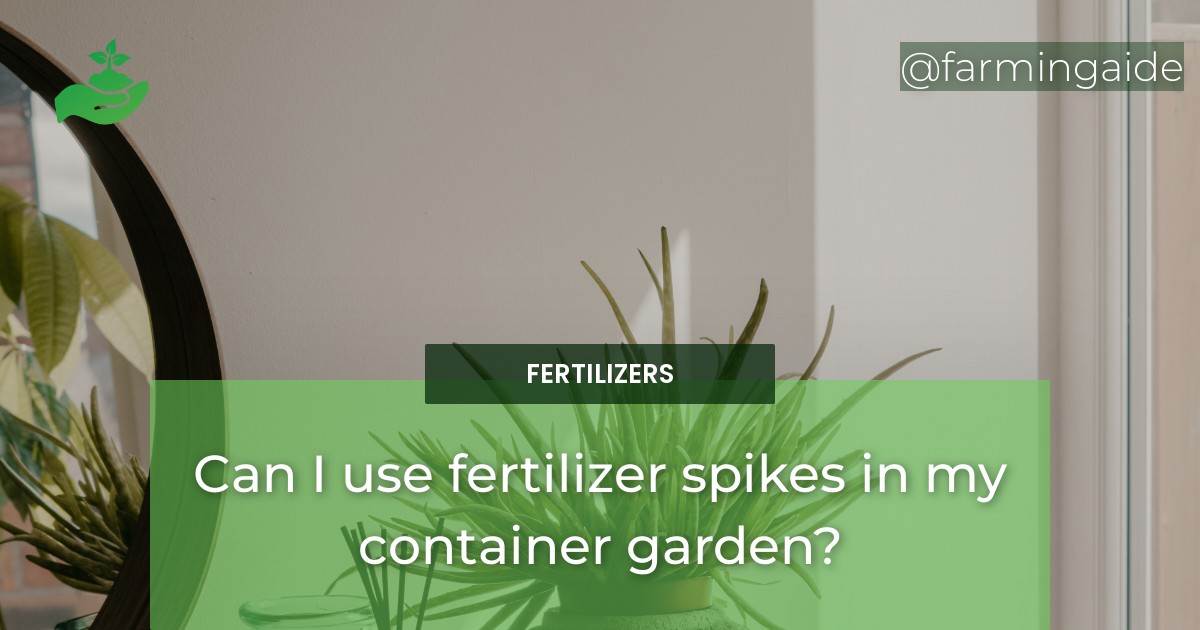Container gardening is a popular way to cultivate plants in small spaces, and it requires proper care to achieve the best results. One question that arises from container gardeners is whether fertilizer spikes can be used in container gardening. The answer is yes, you can use fertilizer spikes in your container garden, but you need to follow some guidelines to ensure their effectiveness and avoid over-fertilization.
Overview of Fertilizer Spikes and Their Benefits
What are Fertilizer Spikes?
Fertilizer spikes are a slow-release type of fertilizer designed to deliver nutrients gradually over time. They consist of compressed fertilizer granules and are placed into the soil of container plants, where they slowly release nutrients into the soil as they dissolve.
Benefits of Using Fertilizer Spikes
The benefits of using fertilizer spikes in container gardening include:
- Convenience: Fertilizer spikes are easy to use and do not require measuring or mixing like traditional fertilizers.
- Slow-release: Fertilizer spikes release nutrients gradually, providing consistent nutrition over an extended period.
- Effective: Fertilizer spikes ensure that nutrients are delivered directly to the root zone, where plants need them the most.
Tips for Using Fertilizer Spikes in Containers
Choosing the Right Fertilizer Spikes for Containers
Choosing the right fertilizer spikes for your container plants is essential to ensure their optimal growth. Look for slow-release fertilizers, which will provide consistent nutrition over several months. The label will indicate the nutrient release rate, which should be matched to the plants’ needs.
When to Use Fertilizer Spikes in Containers
The best time to apply fertilizer spikes in containers is during the growing season when plants are actively growing and have the most demand for nutrients. Avoid using fertilizer spikes during the winter or dormant season when plants are not growing and do not need as many nutrients.
How to Apply Fertilizer Spikes in Containers
To apply fertilizer spikes in containers, follow these steps:
- Water the plants before applying the fertilizer spikes.
- Insert the spikes into the soil, spacing them evenly around the plant’s perimeter.
- Push the spikes down until they are beneath the soil surface.
- Water the plants again to help the fertilizer dissolve and distribute.
Precautions When Using Fertilizer Spikes in Containers
While fertilizer spikes are a convenient and effective way to fertilize container plants, they can also lead to over-fertilization if not used correctly. Over-fertilization can damage plants and harm the environment. To avoid over-fertilization, follow these precautions:
- Do not use more spikes than recommended on the label.
- Do not insert the spikes too close to the plant stem, as this can cause root damage.
- Do not use fertilizer spikes in newly transplanted or stressed plants.
- Monitor the plants for signs of over-fertilization, such as yellowing leaves or stunted growth.
ALSO READ
Other Considerations for Fertilizing Container Gardens
Alternatives to Fertilizer Spikes for Container Gardens
While fertilizer spikes are a convenient option, there are alternatives to consider, such as:
- Liquid fertilizers: These are easy to apply and provide a quick nutrient boost.
- Organic fertilizers: These are made from natural materials and are an eco-friendly option.
- Compost: This is a nutrient-rich soil amendment that can provide slow-release nutrition.
Signs of Overfertilization in Container Gardens
Overfertilization can occur if too much fertilizer is applied or if the wrong type of fertilizer is used. Signs of overfertilization in container gardens include:
- Burned leaves or roots
- Wilting or stunted growth
- Yellowing leaves or leaf drop
- Excessive foliage growth at the expense of flowers or fruit
How to Troubleshoot Fertilizer Spike Application Issues in Container Gardens
If you experience issues with fertilizer spike application in your container garden, consider the following:
- Check the label instructions and ensure that you are using the correct number of spikes and spacing them correctly.
- Ensure that the spikes are fully inserted into the soil and not exposed to the air.
- Consider using a different type of fertilizer or application method if issues persist.


